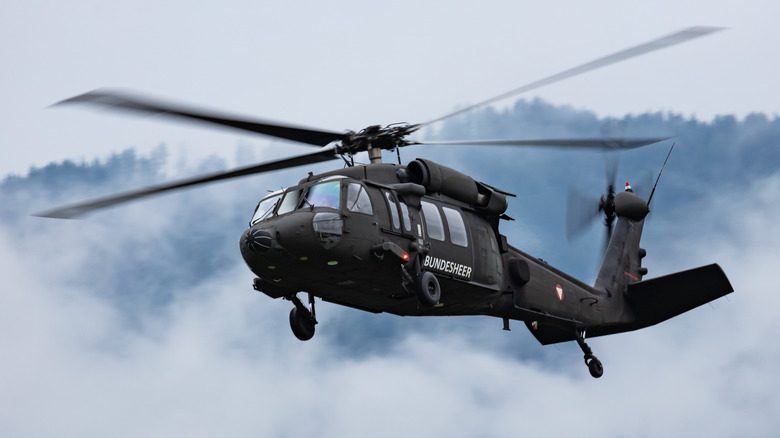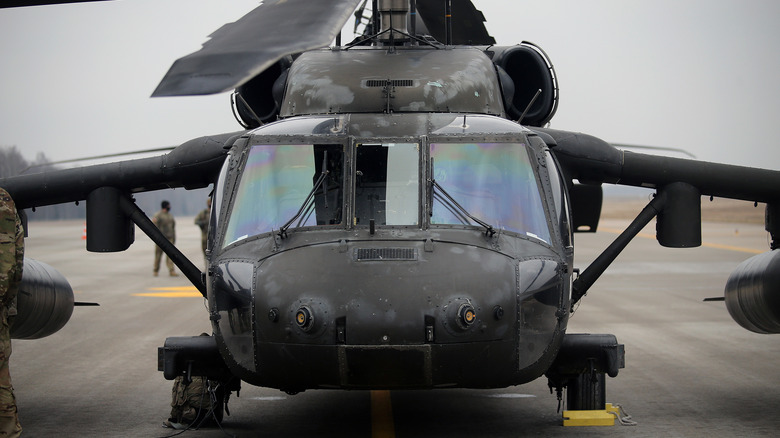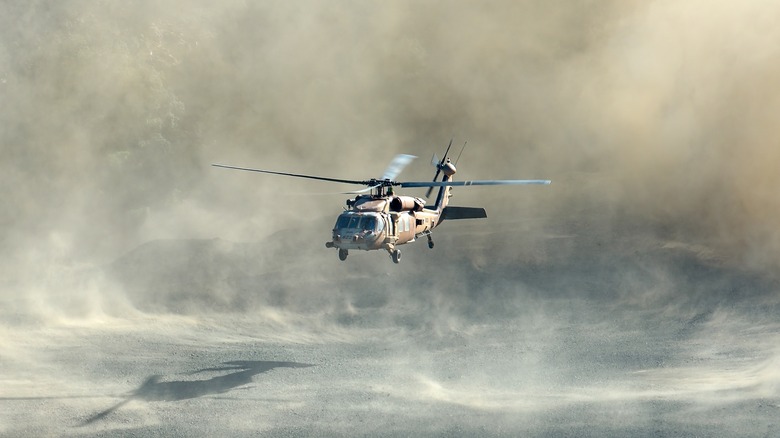How The UH-60 Black Hawk Has Survived In The U.S. Army For Over 40 Years
The designers of military technology face a constant struggle. Ensuring that vehicles, defensive and offensive systems remain at the cutting edge, while also continuing to adhere to an ever-changing grand strategy and global circumstances, is far from an exact science. As such, some tech becomes surplus to requirements even before development is completed. The Soviet Union's gigantic Object 279 tank, for instance, was left behind in the paradigm shift to lighter, more maneuverable tanks.
By the same token, there's some military hardware that's so versatile in design and purpose that it serves an invaluable role in the military for decades (given upgrades and refurbishment where needed along the way). One great example is the iconic UH-60 Black Hawk helicopter, a U.S. Army stalwart.
The Black Hawk is not specialized to perform a single specific role (this trait has spelt doom for other hardware, when that role became obsolete), and its position in the military has evolved as the force itself has. This has allowed it to remain invaluable in a variety of situations. Here's when this remarkable helicopter was first developed, and how it's remained important to the Army ever since.
The UTTAS and the Black Hawk's birth
The Black Hawk was developed by Sikorsky Aircraft. The company that was founded by one Igor Sikorsky, who pioneered helicopter technology the late 1930s. It was introduced as a result of the Utility Tactical Transport Aircraft System contest held by the military, through which they hoped to introduce a new helicopter to the force. The specifications for the contest were for an aircraft that could travel at 320 kph while transporting 3150 kg of cargo (slung). In 1972, Sikorsky responded with its plan for the helicopter that would become the world-renowned Black Hawk. It entered service in 1979.
Helicopters had proven their worth in the Vietnam War, shuttling infantry to and from the battlefield in the kind of tricky terrain that planes certainly couldn't have handled. They could reach troops where other aircraft would have been powerless to help, and by so doing, they were crucial to expanding the reach and effectiveness of the fighting forces they ferried.
In the era of warfare that was unfolding at the time of the Utility Tactical Transport Aircraft System competition, the Black Hawk would expand the capacities of the helicopter further. With M60s affixed to the pintles from the first guise of the aircraft (the Black Hawk first saw use in the non-combat evacuation of Operation Urgent Fury in 1983, with the 158th Aviation Battalion), it was plain to see that the Black Hawk was more than just a passive transporter.
The Black Hawks of today's army
In service beyond four decades, Black Hawks have transformed somewhat. Updated models such as the HH-60M boast greater effective range and cargo capacity, as well as specialized equipment like the MEDEVAC Mission Equipment Package.
The GE-701D that powers the UH-60M (which became the U.S. Army's primary model over the UH-60L in the mid-2000s) ensured that the Black Hawk line's performance remained up to snuff.
In terms of weaponry, too, the Black Hawk remains a formidable prospect. The UH-60A, indeed, can be outfitted with a huge range of devastating equipment with which to engage a range of targets. From FIM-92 Stingers for air assaults to Hellfire missiles, the Black Hawk's External Stores Support Systems allows it to be equipped with formidable weaponry. At the same time, some Black Hawk variants forgo that arsenal and troop space to accommodate six medical litters instead.
With General Electric T700-GE-701 turboshafts, increased stability and operational security, a Black Hawk can be fully outfitted to perform in offensive and supportive operations alike. The roles it fulfills have been crucial, and as it has continued to be adapted to meet them, it has remained an invaluable tool, in the U.S. Army and around the world.. It may be replaced, but it will never be forgotten.


